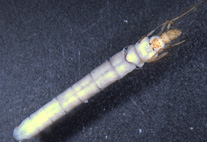Abstract
Cytology and ecology of Chironomus (Chironomus) salinarius Kieffer, 1915 (Diptera, Chironomidae) was examined from material collected in the saline rivers of the Lake Elton basin (Volgograd region, Russia). Larvae of salinarius-type were identified as C. salinarius on the basis of their karyotype. The species is redescribed on the basis of all metamorphic stages. The reared imago and karyotype were obtained from larvae of the same population. The karyotype of C. salinarius, detailed mapping of the 5 chromosome arms A, C, D, E, F and characteristics of chromosome polymorphism are provided. Information on distribution and ecology of C. salinarius from the saline rivers (total mineralization 6.8–31.6 g l-1) of the Lake Elton basin is also given. Chironomus salinarius is a common in the saline rivers and occurs in sediments with high silt content. On the basis of recent samplings C. salinarius appears to be very abundant in saline, mesotrophic as well as in eutrophic rivers. Chironomus salinarius accounted for 49–66% of total abundance of zoobenthos in water with salinity up to 13–31.6 g l-1.

